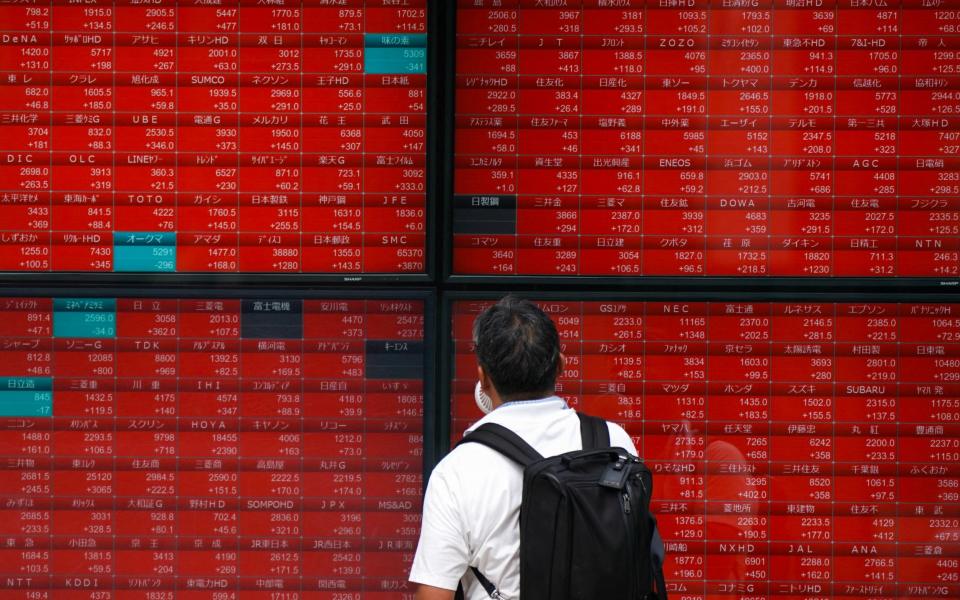Finance
Japan nearly blew up global markets this week – here’s how it could happen again

With plummeting stock prices, major unrest on Wall Street and rumors of emergency interest rate cuts in the US, it has been a dramatic week for the markets – and for the millions of savers who depend on them for their investment returns.
What would have been minor turbulence turned into full-blown panic as an obscure form of currency trading imploded on the other side of the world.
The result has left everyone from ordinary people involved in investing to large pension funds feeling sore and looking for ways to make money back amid the chaos.
In Britain, where fears of a recession have faded after last year’s slump, some economists even began warning that the turmoil would threaten growth.
The root of the problem is an investment strategy that few will have heard of: the yen carry trade.
It’s a complex way for investors to make money and has led to the build-up of hundreds of billions of dollars in Japan.
“In principle, many investors – some Japanese, many international – would borrow money in yen at very low interest rates to invest in other countries where yields are higher,” said Andres Sanchez Balcazar, head of global bonds at Pictet Asset Management.
Anyone taking out a mortgage or loan in Britain or the US will be well familiar with the pain of interest rates hovering around 5%. But in Japan you can still borrow money virtually for free.
As a result, investors such as hedge funds and investment banks have taken on large debts there. They then exchanged the borrowed yen into another currency where interest rates are higher, such as US dollars or Mexican pesos.
“A carry trade essentially just tries to take advantage of higher interest rates in one area and finance it out of a low interest rate environment in another area. Carry is really just another word for interest,” says Tristan Hanson, fund manager at M&G.
Normally, a trader would then simply leave the investments and take advantage of the short-term money market rates in each of these currencies, Balcazar says.
“Some people spice it up a bit. In the more speculative version, it would, for example, concern corporate bonds or emerging market bonds, or sometimes shares.
“Maybe some of it found its way into tech stocks, which everyone thought would go up forever.”
This means that an investor with a higher risk appetite may have borrowed money in Japan, exchanged it for dollars or pounds and used it to effectively lend money to Sainsbury’s, buy Ghanaian government bonds or buy shares in Apple.
“That’s all fine as long as the yen depreciates,” says Balcazar.
Last month, Donald Trump raised the temperature for investors who saw the money pouring in. He suggested in an interview that the dollar was too strong against the Chinese and Japanese currencies, causing American manufacturers to struggle to sell their products.
“We have a big currency problem,” the former president, who hopes to win the US elections in November, told Bloomberg.
Meanwhile, as central banks around the world started cutting interest rates, the Bank of Japan surprised everyone by raising borrowing costs from 0.1% to 0.25%, signaling its willingness to go further .
“The market is partly triggered by deteriorating US economic databut reacting in a way that is consistent with a much greater deterioration than what we actually saw,” said Sam Lynton Brown, head of global macro strategy at investment bank BNP Paribas.
“That much larger movement in the market can well be explained by positioning, and in particular, when it comes to Japan, by the unwinding of what has been a very, very big trend.”
This resulted in a domino effect. It illustrates how seemingly isolated events, such as a comment from Donald Trump, a decision by Japanese technocrats and a few traders sitting at the desks in August, contributed to the stock market collapse.
“The market was a bit complacent and was on a very large carry trade. You just need some of those people to say, ‘I don’t want it anymore,’” Balcazar says.
“So they sell the foreign currency and buy the yen, close out their yen liabilities and close out the investments in other currencies.
“It has a snowball effect because so many people are dealing with this situation – especially during the summer months [when] liquidity is not great. And so you end up having these very excessive market movements.
The impact spread like wildfire across global markets, affecting people and institutions everywhere from Britain to emerging markets.
“A large part of the market has been invested in this carry trade in the US, Europe and emerging markets.
“Suddenly you’ve got people trading online and your typical UK pension plan would have, for example, shares or corporate bonds, and then they’re going to be affected by these falling stock markets,” says Balcazar.
This is echoed by Hanson at M&G.
“If your portfolio is down by X, you should close positions because you don’t want to lose double that amount. You get people all trying to do the same thing at the same time,” he says.
Analysts at ING estimate that cross-border lending from Japan had reached $1 trillion by March 2024, a fifth increase since 2021.
As a result, it is difficult to say how much of the yen carry trade remains to be unwound. There could be more pain to come, both in the short and long term.
“The market will test people’s nerves in the coming weeks. I don’t think it’s going to be plain sailing, because when you get these volatility events, they tend to stick around for a while, and they’re unsettling to people,” says Hanson.
He has been buying Japanese and Korean stocks this week, believing the sell-off was “very large and not really based on good fundamental reasons.”
“When you experience a major market shock like we did, it is foolish to end it right away because movements can be self-fulfilling. We have had a very big shock,” says Brown of BNP Paribas.
He adds that investors invest in many other types of similar transactions, for example in the Chinese yuan.
“These are actually all the same things. They do well when volatility is low, but poorly when volatility is high,” he says.
Wall Street’s fear gauge – a measure of market volatility – hit a four-year high on Monday.
Meanwhile, most traders expect that we are not only in for a more volatile summer, but also a more volatile decade.
Geopolitics, fluctuating inflation and the trillions of pounds needed to fund the net zero transition all make for a more uncertain world.
But if anything, such carry trades will become increasingly common in “this new era of higher and more diverse interest rates,” Balcazar says.
Higher interest rates force investors to find creative ways to generate returns that are better than just putting the money in the bank at a profitable rate.
“Interest rates tend to be quite low in Asia, while in the Western world, especially the US and Latin America, they tend to be quite high. That really invites carry trade,” he says.
“The other element is that this is an election year. Elections provide very good volatility, which can sometimes undo these carry trades.”
In other words, the carry trade in the yen could become a lot less murky in the coming years.







